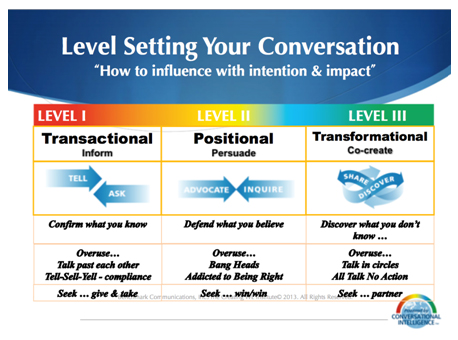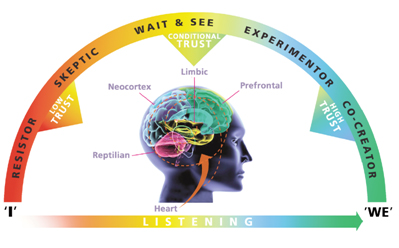 I spoke to Judith Glaser about how conversational intelligence can help you better connect with others and grow your career. Glaser is the author of Conversational Intelligence: How Great Leaders Build Trust & Get Extraordinary Results, the CEO of Benchmark Communications, Inc. and the chairman of The Creative WE Institute. Below is a brief interview where I ask her questions about conversational intelligence, her tips to communicate more effectively in the office, how to customize your message, and more.
I spoke to Judith Glaser about how conversational intelligence can help you better connect with others and grow your career. Glaser is the author of Conversational Intelligence: How Great Leaders Build Trust & Get Extraordinary Results, the CEO of Benchmark Communications, Inc. and the chairman of The Creative WE Institute. Below is a brief interview where I ask her questions about conversational intelligence, her tips to communicate more effectively in the office, how to customize your message, and more.
Dan Schawbel: What is conversational intelligence and why is it important to employees and managers at work?
Judith Glaser: Conversational Intelligence is the hardwired, and learnable ability, to connect, navigate and grow with others – a necessity in building healthier and more resilient organizations in the face of change. Conversational Intelligence measures the level of trust that you create with others – and the quality of interactions and conversations that result.
Conversations have 3 Levels; each has a purpose and result. Each can be done effectively where the intention and impact are aligned, or they can be carried out ineffectively in which case they stir up unintended emotions and feelings and lead to an erosion of trust.

Dan: What are some of your tips to have more effective conversations at work?
Judith: There are many great tips from Conversational Intelligence – however here are a few that are the backbone to having more effective conversations. If you want to elevate your C-IQ – do LAPS…
- Listen to connect not reject – when we listen to connect we are listening non-judgmentally. People pick the signals of judgment up very quickly and get defensive. Listening to connect is felt as ‘positive’ and stimulates more oxytocin, which is the bonding hormone.
- Ask questions for which you have no answers – too often we ask questions to guide people to where we want them to go. That is felt by others as leading questions and can be interpreted as manipulation, putting people on guard. When we ask questions for which we have no answers, we are in a mindset of discovery and others feel this as inquisitive and curious – which puts people into a co-creating and receptive state of mind.
- Prime for trust – start out by building rapport with others. Take the time to get to know them as people. This primes the conversation and relationship for trust. It starts the engagement or exchange in a positive way. It ‘warms the conversation’ and gives the people a chance to ‘feel each other out’ – and to get back an indication they are trust worthy. The conversation will be dramatically different from that point on.
- Sustain conversational agility – if the conversation is stuck, or you are not getting the results you were hoping for (your intention and impact are out of sync), use agility skills like reframe, refocus and redirect. When you see a reaction you don’t intend or want to create, say – ‘let me reframe that another way.’ This gives you and the other person a chance to reset you minds and be open to another way to interpret what is going on. It’s like ‘making up’ and moving on to a better conversational pathway.
Dan: How do you know when to change the tone and message in your conversation to match the audience and situation?
Judith: We are always sending signals to each other about how we feel about a conversation while it’s happening. However we have not been trained to understand exactly what these signals are or how to interpret them in a healthy way so we miss them, talk past each other or stop listening …
Our brain picks up messages of trust and distrust in .07 seconds – it’s that instantaneous. Then as we receive the ‘feel, sense, see and hear’ signals we try to process them and put words to them. It takes much longer to interpret what we are sensing or picking up and we often add interpretations and meaning that doesn’t exist.
I created a Conversational Dashboard that makes it easier to interpret and respond to the ‘signals’ that something is not going well.
When you see people resist – it’s a sign the reptilian brain (often called the amygdala) has become activated and the person is in protect behavior. When this happens, pushing back on them, being aggressive, telling too much or demanding compliance will only increase resistor behaviors. Know that this is the time to quell ‘their amygdala’ not aggravate it. By lowering your tone of voice, by being more responsive to their needs, and by giving them space, you are sending messages to their amygdala that you are not a foe rather are a friend. These are the subtle signals that are being exchanged minute by minute during conversations. Knowing how to move people from the left side of the Conversational Dashboard to the right is essential and vital for all leaders today.
Dan: What are some ways to connect with people of different generations and levels of an organization?
Judith: Research shows that it’s easier for us to get along with people who are ‘just like us.’ Our brains pick up that we are similar or different and respond accordingly. People of different generations can be perceived as ‘different’ – and in many ways they are. Millennials think differently from Baby Boomers, for example, however these differences don’t need to stop people from engaging and connecting. Where the difference is generational or positional, the response is the same – instead of fearing them, or judging them as difficult or different, go into the conversation with curiosity and openness to connect. Respect goes a long way to open the brain and mind to connection. Reaching out to others stimulates the flow of oxytocin, and we will find getting to know others much easier. Remember to use the Conversational LAPS… (in question 2)
Dan: What are the most common mistakes you see workers make when engaging in important conversations?
Judith: When engaging in important conversations fear takes over all too often. When we are in situations where the stakes are high, there is a lot to lose. This activates the production of ‘cortisol’, which is our fear hormone. We call this imagining ‘feared implications’ – or worst case scenarios. Our behavior shifts in the moment. We go into tell-sell-yell behaviors and fight for what we want to see happen. We become addicted to being right, and stop listening to what others are saying. However we may not recognize this until it’s too late or not at all. In essence we activate the opposite behaviors that we want to bring into the situation. We lose our voice, activate our ‘blindspots’ and do not see the implications; we stop listening, seeing and hearing others – at great expense.

